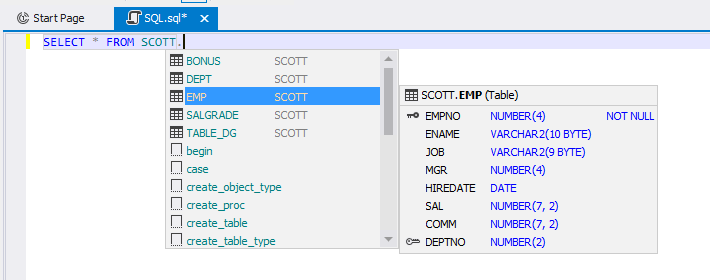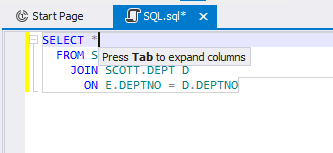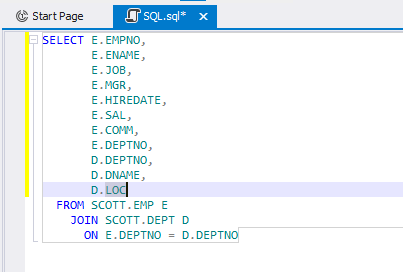Creating and Editing a Query
This topic explains how to create and edit a SQL query in dbForge Studio for Oracle.
To create a query:
- Create a server connection. For more information about how to connect to a database, see the Creating a database section in Managing Database Connections.
-
On the Start Page > SQL Development tab, click SQL Editor.
-or-
On the Standard toolbar, click New SQL or press CTRL+N.
- Start type a query to a database.
- To execute the query, click Execute or press CTRL+F5.
Coding Techniques Example
The dbForge Studio SQL editor provides many features that make it easier for you to write and manage your code. Let’s explore some Intellisense features that assist you while coding.
As an example, we’ll use the SCOTT database and perform a sample query where we display all the employees working in the Sales departments.
- Open the SQL Editor.
-
Start typing the SELECT statement. Enter first three letters sel. dbForge Studio shows you the list of the relevant keywords and snippets. You can select the SELECT keyword from the list and press ENTER. The keyword appears in the SQL editor. You can also select the sel snippet from the list and press the TAB button. In this case the SELECT * FROM statement appears in the SQL editor.

If you start type the same letters sel a little faster, before the list appears (by default the list has 200 ms delay), a little tool tip appears next to the letters. It signals that you can press the TAB button to complete the statement automatically by inserting a snippet.

Regardless of the method you choose, the SQL editor displays the SELECT * FROM statement.
-
Now, lets type a table name from which we want to retrieve the data. Start type e. dbForge Studio shows you a list of valid members from the HR database. If you continue typing characters, the list is filtered to include only the members that begin with those characters. After selecting an item, you can insert it into your code by pressing TAB or ENTER. dbForge Studio also shows a quick info for every highlighted item in the list. It allows you to see the object structure immediately.

The EMPLOYEES table comes the third on the list, so choose it and press TAB or ENTER to insert it into the SQL editor. dbForge Studio assigns the alias for the EMPLOYEES table automatically.
-
We need to select employee categories that are stored in separate tables. In a similar way, either type or insert the JOIN keyword and press ENTER. dbForge Studio shows you all available solutions to implement JOIN. Select required statement and press ENTER.

- The last step in creating a query is to add the condition. Add the AND E. DEPARTMENT_ID = 50 statement at the end of the query.
- To format the query text, press CTRL + K, D combination or choose the Advanced option, on the Edit menu, and click Format Document. Now, we can execute the query to see results. To do this, click the Execute button on the Debug toolbar, or press F5.
-
Place the cursor after the asterisk character and press TAB.

dbForge Studio shows the columns list that are available in the EMPLOYEES table.

-
There is no need to retrieve all the columns from the EMPLOYEES table, so we can leave only required ones.

We got what we wanted.
As you can see, the IntelliSense-like code completion provided by dbForge Studio allows you to create complex queries in a few keystrokes.